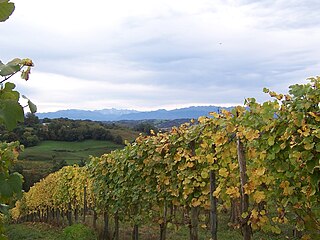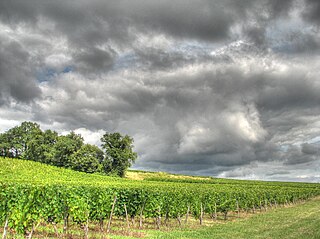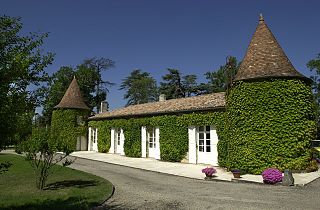
Chenin blanc is a white wine grape variety from the Loire Valley of France. Its high acidity means it can be used to make varieties from sparkling wines to well-balanced dessert wines, although it can produce very bland, neutral wines if the vine's natural vigor is not controlled. Outside the Loire, it is found in most of the New World wine regions; it is the most widely planted variety in South Africa, where it was historically also known as Steen. The grape may have been one of the first to be grown in South Africa by Jan van Riebeeck in 1655, or it may have come to that country with Huguenots fleeing France after the revocation of the Edict of Nantes in 1685. Chenin blanc was often misidentified in Australia, as well, so tracing its early history in the country is not easy. It may have been introduced in James Busby's collection of 1832, but C. Waterhouse was growing Steen at Highercombe in Houghton, South Australia, by 1862.

Graves is an important subregion of the Bordeaux wine region. Graves is situated on the left bank of the Garonne River, in the upstream part of the region, southeast of the city Bordeaux and stretches over 50 kilometres (31 mi). Graves is the only Bordeaux subregion which is famed for all three of Bordeaux' three main wine types—reds, dry whites and sweet wines—although red wines dominate the total production. Graves AOC is also the name of one Appellation d'origine contrôlée (AOC) which covers most, but not all of the Graves subregion.

Bergerac is a subprefecture of the Dordogne department, in the region of Nouvelle-Aquitaine, Southwestern France. In 2018, the commune had a population of 26,823, which made it the department's second-most populated after the prefecture Périgueux. Located on the banks of the river Dordogne, Bergerac was designated a Town of Art and History by the Ministry of Culture in 2013.

Bordeaux wine is produced in the Bordeaux region of southwest France, around the city of Bordeaux, on the Garonne River. To the north of the city the Dordogne River joins the Garonne forming the broad estuary called the Gironde; the Gironde department, with a total vineyard area of 110,800 hectares, is the largest wine growing area in France.

French wine is produced all throughout France, in quantities between 50 and 60 million hectolitres per year, or 7–8 billion bottles. France is one of the largest wine producers in the world, along with Italian, Spanish, and American wine-producing regions. French wine traces its history to the 6th century BCE, with many of France's regions dating their wine-making history to Roman times. The wines produced range from expensive wines sold internationally to modest wines usually only seen within France such as the Margnat wines of the post war period.

The wine regions of Bordeaux are a large number of wine growing areas, differing widely in size and sometimes overlapping, which lie within the overarching wine region of Bordeaux, centred on the city of Bordeaux and covering the whole area of the Gironde department of Aquitaine.

Entre-Deux-Mers is a French region, well known as a Bordeaux wine growing region. The geographical area is situated between the rivers Garonne and Dordogne, and is bounded in the east by the border of the Gironde department and in the west by the Bec d'Ambès, the confluence of the Garonne and the Dordogne.

The Loire Valley wine region includes the French wine regions situated along the river Loire from the Muscadet region near the city of Nantes on the Atlantic coast to the region of Sancerre and Pouilly-Fumé just southeast of the city of Orléans in north central France. In between are the regions of Anjou wine, Saumur, Bourgueil, Chinon, and Vouvray. The Loire Valley itself follows the river through the Loire department to the river's origins in the Cévennes but the majority of the wine production takes place in the regions noted above. The area includes 87 appellations under the Appellation d'origine contrôlée (AOC), Vin Délimité de Qualité Superieure (VDQS) and Vin de pays systems. While the majority of production is white wine from the Chenin blanc, Sauvignon blanc and Melon de Bourgogne grapes, there are red wines made from Cabernet franc. In addition to still wines, rosé, sparkling and dessert wines are also produced. With Crémant production throughout the Loire, it is the second largest sparkling wine producer in France after Champagne. Among these different wine styles, Loire wines tend to exhibit characteristic fruitiness with fresh, crisp flavors-especially in their youth. The Loire Valley has a long history of winemaking dating back to the 1st century. In the High Middle Ages, the wines of the Loire Valley were the most esteemed wines in England and France, even more prized than those from Bordeaux.

In the Bordeaux wine region there are seven regional Appellations d'origine contrôlée (AOCs) that may be used throughout the Gironde department. These are Bordeaux Rouge AOC, Bordeaux Supérieur Rouge, Bordeaux Clairet, Bordeaux Rosé, Bordeaux Blanc, a dry white, Bordeaux Supérieur Blanc, a sweet white, and Crémant de Bordeaux, a sparkling méthode traditionnelle wine. The regional appellations together form the largest world-class wine vineyard, making up more than half of the production of the prestigious Bordeaux wine region, and representing more than 55% of all Bordeaux wines consumed in the world.

Provence (Provençal) wine comes from the French wine-producing region of Provence in southeast France. The Romans called the area provincia nostra, giving the region its name. Just south of the Alps, it was the first Roman province outside Italy.

South West France, or in French Sud-Ouest, is a wine region in France covering several wine-producing areas situated respectively inland from, and south of, the wine region of Bordeaux. These areas, which have a total of 16,000 hectares of vineyards, consist of several discontinuous wine "islands" throughout the Aquitaine region, and more or less to the west of the Midi-Pyrénées region.

Côtes de Bourg is an Appellation d'origine contrôlée (AOC) for Bordeaux wine situated around the small town of Bourg-sur-Gironde near Bordeaux, France. The first vineyards in the area were founded by the Romans. In the Middle Ages, Bourg was a major port for wine and the vineyards developed at the same tempo as the estuary traffic. The Côtes de Bourg appellation, in the north of the patchwork of Bordeaux wines, took its first steps on the east bank of the Gironde. At the time, the inhabitants of Bourg were fishermen, sailors or winemakers and the latter benefited from the perfect combination of a commercially minded town and a soil made for the vine.

Anjou wine is produced in the Loire Valley wine region of France near the city of Angers. The wines of region are often grouped together with the wines of nearby Saumur as "Anjou-Saumur". Along with the wines produced further east in Touraine, Anjou-Saumur make what is collectively known as the "Middle Loire" (as opposed to the "Upper Loire" which includes the wine regions of Sancerre and Pouilly-Fumé. Within the Anjou wine region are several Appellation d'origine contrôlées responsible for a broad spectrum of wines including still red, white and rosé produced with varying levels of sweetness. Extending across the Deux-Sèvres, Maine-et-Loire and Vienne départements, the generic Anjou AOC appellation and its various sub-appellations encompasses vineyards across more than 151 communes.

Touraine-Amboise is an Appellation d'Origine Contrôlée (AOC) for in the Loire Valley wine region in France. It is situated within the wider Touraine AOC wine appellation. It is produced by ten communes bordering both sides of the River Loire. To their west lies the town of Amboise with its famous royal château. Since its separation from the Touraine AOC in 1954, it has constituted an AOC in its own right. Annual production stands at 9,000 hectolitres of wine, spread between red, rosé, and still white wines. Effervescent wines are also produced within this AOC's boundaries, but they are not entitled to use the Touraine-Amboise appellation, belonging instead to the Touraine appellation.

Touraine is an Appellation d'Origine Contrôlée (AOC) in the Loire Valley wine region in France that produce dry, white wines and red wines rich in tannins. The AOC status was awarded by a decree of December 24, 1939. The wine-growing area extends over 5,300 hectares departments of Indre-et-Loire, Indre and Loir-et-Cher and comprises a total of 70 communes and it is thus a "subregional" appellation covering the same area as a number of local AOCs.

Cadillac is an Appellation d'Origine Contrôlée (AOC) for sweet white wine from the Bordeaux wine region in France. It is located within the Entre-Deux-Mers subregion of Bordeaux. It takes its name from the town of Cadillac-sur-Garonne, formerly known as Cadillac.

Côtes de Duras is an Appellation d'Origine Contrôlée (AOC) for red and white wines in South West France. Côtes de Duras is located in the department of Lot-et-Garonne, and is located immediately adjacent to the Bordeaux wine region, which is restricted to the Gironde department, as an extension of Bordeaux immediately to the east of the departmental border.
Graves de Vayres is an Appellation d'Origine Contrôlée (AOC) for red and white wines in the Bordeaux wine region of France. It covers 700 hectares across the Vayres and Arveyres communes and is located within the Entre-Deux-Mers subregion of Bordeaux.

Saint-Georges-Saint-Émilion is an Appellation d'origine contrôlée (AOC) for wine in the Bordeaux wine region of France, where it is situated in the Libourne subregion on the right bank of the Dordogne. It was granted AOC status on 14 November 1936, and the AOC designation granted to the wines which have been harvested on the land of the Saint-Georges-Saint-Émilion hamlet, which is part of Montagne commune. 192 hectares of vine planted areas belonged to the appellation in 2005, with a production of 9,333 hl.

Château Suau is a French vineyard located south of the village of Capian in the Bordeaux area. It sits at the highest point of the Cadillac-côtes-de-Bordeaux appellation. Château Suau produces organic wines.

















